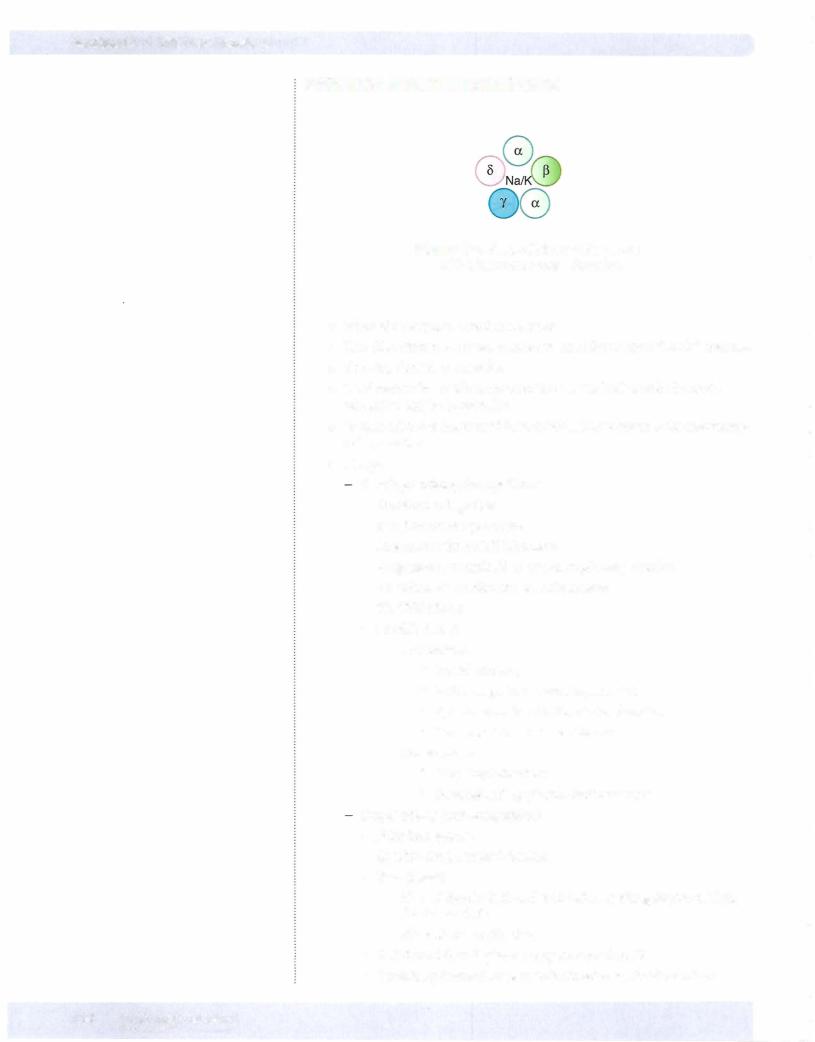
- •Contents
- •1. Pharmacokinetics
- •3. Practice Questions
- •2. Antiarrhythmic Drugs
- •3. Antihypertensive Drugs
- •3. Anticonvulsants
- •5. Opioid Analgesics
- •8. Drugs of Abuse
- •1. Antibacterial Agents
- •4. Antiprotozoal Agents
- •1. Histamine and Antihistamines
- •3. Drugs Acting on Serotonergic Systems
- •1. Drugs Used in Diabetes
- •2. Steroid Hormones
- •6. Endocrine Drug List
- •1. Anticancer Drugs
- •1. Immunopharmacology
- •1. Toxicology
- •2. Toxicology Practice Questions
- •Index

Anticonvulsants 3
•
•
Seizures result from episodic electrical discharges in cerebral neurons associated with prolonged depolarization, during which sustained, high-frequency, repetitive firing (SHFRF) occurs, followed by prolonged hyperpolarization. The goal of drug management is restoration of nor mal patterns of electrical activity.
Mechanisms of action:
-j, axonal conduction by preventing Na+ influx through fast Na channels-carbamazepine, phenytoin
-I inhibitory tone by facilitation of GABA-mediated hyperpolariza tion-barbiturates, benzodiazepines
j, excitatory effects of glutamic acid-lamotrigine, topiramate
(blocks AMPA receptors); felbamate (blocks NMDA receptors)
1, presynaptic Ca2+ influx through type-T channels in thalamic neurons-ethosuximide and valproic acid
Table IV-3-1. Seizure States and Drugs of Choice
Seizure Type |
Effective Drugs |
Partial-simple or complex |
Valproic acid, phenytoin, carbamazepine, |
|
lamotrigine |
General-tonic-clonic |
Valproic acid, phenytoin, carbamazepine, |
|
lamotrigine |
General-absence |
Ethosuximide, valproic acid |
Status epilepticus |
Lorazepam, diazepam, phenytoin, |
|
or fosphenytoin* |
*IV fosphenytoin is more water soluble.
• Primary anticonvulsants
Phenytoin
0Blocks axonal Na+ channels in their inactivated state
0Prevents seizure propagation
0Uses: seizure states
M EDICAL 137

Section IV • CNS Pharmacology
0Pharmacokinetics: Variable absorption Nonlinear kinetics
Induction of cytochrome P450s Zero-order kinetic of elimination
0Side effects:
CNS depression Gingival hyperplasia Hirsutism
Osteomalacia (J, vitamin D) Megaloblastic anemia (J, folate)
Aplastic anemia (check hematology lab results) 0 Teratogenicity: cleft lip and palate
Carbamazepine
0Mechanism identical to phenytoin
0Uses:
Seizure states
DOC for trigeminal neuralgia
Bipolar disorder
0Pharmacokinetics: induces cytochrome P450, including its own metabolism
0Side effects:
CNS depression Osteomalacia Megaloblastic anemia Aplastic anemia Exfoliative dermatitis
1' ADH secretion (dilutional hyponatremia) 0 Teratogenicity:
Cleft lip and palate Spina bifida
Valproic acid
0 Mechanism:
Similar to phenytoin
But also inhibition of GABA transaminase Blockade of T-type Ca2+ channels
0 Uses:
Seizure states
Mania of bipolar disorders Migraine prophylaxis
0 Pharmacokinetics: inhibits cytochrome P450s
138 MEDICAL

Chapter 3 • Anticonvulsants
0 Side effects:
Hepatotoxicity (from toxic metabolite) Thrombocytopenia
Pancreatitis Alopecia
0 Teratogenicity: spina bifida
Ethosuximide
0Mechanism: blockade of T-type Ca2+ channels in thalamic neurons
0Use: absence seizures
•General features of anticonvulsant drug use:
Anticonvulsants are additive with other CNS depressants Avoid abrupt withdrawal, which may precipitate seizures
J, efficacy of oral contraceptives via induction of cytochrome P450
• Other anticonvulsant drugs
Felbamate and lamotrigine
0Block Na+ channels and glutamate receptors
0Used in seizure states (often adjunct therapy)
0Side effects:
Hepatotoxicity and aplastic anemia (felbamate)
Stevens-Johnson syndrome (lamotrigine)
 Gabapentin
Gabapentin
0i GABA effects
0Used in seizure states, neuropathic pain (such as postherpetic neuralgia)
Chapter Summary
•Seizures are caused by episodic electrical discharges in cerebral neurons. These trigger repetitive firing and prolonged hyperpolarization. The goal of drug management is to restore normal electrical patterns. Different classes of drugs do this by acting on different receptor/transmitter systems, which are listed.
•Table IV-3-1 summarizes the drugs of choice available to treat each ofthe several types of seizures.
•The mechanisms of action, metabolism, and the adverse effect ofthe primary anticonvulsant drugs (phenytoin, carbamazepine, ethosuximide, valproic acid, and the barbiturates and benzodiazepines) are discussed.
•Anticonvulsive drugs in general have additive depressive effects when used with other depressant drugs, cause a precipitation of seizures upon abrupt withdrawal, and decrease the efficiency of oral contraceptives.
•Other anticonvulsants listed are felbamate, gabapentin, and lamotrigine.
MEDICAL 1 39



Section IV • CNS Pharmacology
-MAC values are lower in the elderly and in the presence of opiates or sedative-hypnotics.
•Rates of onset and recovery depend on the blood-gas ratio:
The more soluble the anesthetic in the blood, the slower the anesthesia. Anesthetics with high blood-gas ratios are associated with slow onset.
Anesthetics with high blood-gas ratios are associated with slow recovery.
Anesthetics with low blood-gas ratios have fast onset and recovery.
Intravenous Anesthetics
• Thiopental
Barbiturate used for induction
Highly lipid soluble; rapid onset; short-acting due to redistribution
• Midazolam
Benzodiazepine used for:
0Preoperative sedation
0Anterograde amnesia
0Induction
0Outpatient surgery Depresses respiratory function
•Propofol
Used for induction and maintenance of anesthesia Antiemetic
CNS and cardiac depressant
• Fentanyl
Opiate used for induction and maintenance of anesthesia Depresses respiratory function
See Opioid Analgesics; chapter 5 in this section
• Ketamine
Dissociative anesthetic NMDA-receptor antagonist Induction of anesthesia Emergent delirium, hallucinations Cardiovascular stimulation
- i intracranial pressure
142 MEDICAL


Section IV • CNS Pharmacology
SKELETAL MUSCLE RELAXANTS
Figure IV-4-3. Nicotinic ACh Receptor
of the Neuromuscular Junction
•Nicotinic receptors have five subunits.
•Two ACh bind each to two a subunits in order to open the Na+ channel.
•This depolarizes the muscle.
•Used mainly in anesthesia protocols or in the ICU to afford muscle relaxation and/or immobility.
•Muscle relaxants interact with nicotinic ACh receptors at the neuromus cular junction.
•Drugs:
Nondepolarizing (competitive)
0Nicotinic antagonists
0D-Tubocurarine prototype
0Reversible with AChE inhibitors
0Progressive paralysis (face, limbs, respiratory muscle)
0No effects on cardiac and smooth muscle
0No CNS effects
0Specific drugs:
Atracurium
*Rapid recovery
*Safe in hepatic or renal impairment
*Spontaneous inactivation to laudanosine
*Laudanosine can cause seizures
Mivacurium
*Very short duration
*Metabolized by plasma cholinesterases
Depolarizing (noncompetitive)
0Nicotinic agonist
0Specific drug: succinylcholine
0Two phases:
PhaseI: depolarization, fasciculation, prolong depolarization, flaccid paralysis
Phase II: desensitization
0AChE inhibitors i phase I; may reverse phase II
0Rapidly hydrolyzed by pseudocholinesterase: short duration
1 44 MEDICAL

° Cautions:
Atypical pseudocholinesterase Hyperkalemia
Malignant hyperthermia
Centrally Acting Skeletal Muscle Relaxants
•Benzodiazepines through GABAA receptors
•Baclofen through GABAB receptors
•Use: spasticity
Chapter Summary
Drugs Used in Anesthesia
•The more lipid soluble the inhalation anesthetic, the greater its potency
(lower MAC value). The more soluble an inhalation anesthetic in the blood (higher blood:gas ratio), the slowerwill be the onset to anesthesia and the slowerwill be the recovery.
•Thiopental, midazolam, propofol, fentanyl, and ketamine are intravenous anesthetics that are discussed.
•Local anesthetics (weak bases) infiltrate and anesthetize nerve bundles near sites of injection by binding to inactive Na+ channels in their ionized forms. However, to getto the channel they must diffuse through the lipid bilayer in an unionized form. Thus, their effects are influenced by pH.
•The smaller and most rapidly firing nerve fibers are the most sensitive to blockade.
•The coadministration of alpha adrenoceptor agonists decreases local anesthetic absorption into the systemic circulation, prolonging their effects and potentially decreasing their toxicity.
•The adverse effects of local anesthetics are given.
Sodium Channel Toxins
•Tetrodotoxin, saxitoxin, ciguatoxin, and batrachotoxin are sodium-channel toxins found in various fish, frogs, or dinoftagellates.
Skeletal Muscle Relaxants
•The skeletal muscle relaxants provide muscle relaxation and/or immobility via N-receptor interactions. Most, including o-tubocurarine, atracurium, and
mivacurium, are competitive and nondepolarizing and can be reversed byAChE inhibitors. Succinylcholine is a depolarizing, noncompetitive agonist.
•Spasmolytics reduce excess muscle tone or spasm in injury or CNS dysfunction. They may act in the CNS, the spinal cord, or directly on the muscle.
Benzodiazepines and baclofen reduce the tonic output ofspinal motor neurons. Dantrolene blocks Ca2+ release from the muscle sarcoplasm reticulum.
Chapter 4 • Drugs Used in Anesthesia
Bridge to Pathology/Genetics
Malignant Hyperthermia
A life-threatening syndrome characterized by muscle rigidity, hyperthermia, hypertension, acidosis, and hyperkalemia. Associated with the use of skeletal muscle relaxants, especially succinylcholine, used in anesthesia regimens. Genotypic susceptibility may be related to mutations in the genes encoding ryanodine receptors and/or a protein component of the L-type calcium channel in skeletal muscle.
Treatment
Dantrolene acts directly on skeletal muscle to decrease contractility by blocking Ca2+ release from the sarcoplasmic reticulum. It is used in states that include extreme muscle rigidity, such as malignant hyperthermia associated with inhaled anesthetics and skeletal muscle relaxants or neuroleptic
malignant syndrome associated with antipsychotics.
MEDICAL 145

